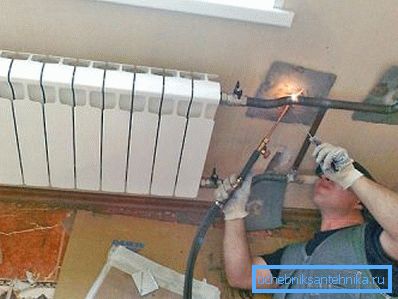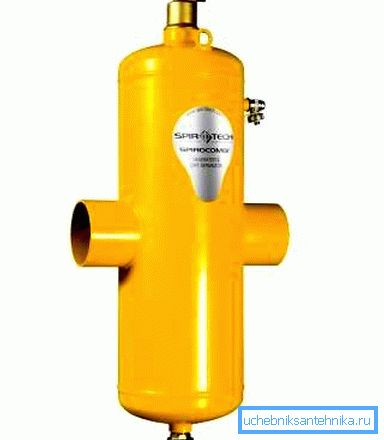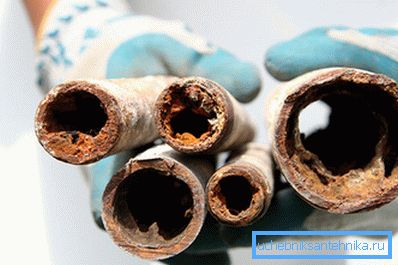Air heating system: how to quickly and easily remove the
A prerequisite for the normal heating of the house is the absence of air in it. They lead to a decrease in heating efficiency, corrosion of metal elements, increased noise in pipes and other troubles. That is why now we will talk about how to expel air from the heating system.
The instructions below will help you do this operation yourself, without resorting to the expensive services of plumbers.

Causes of
What is the air in the heating system - not by hearsay almost every one of us knows. Especially often residents of urban apartments connected to centralized heating face a similar problem. Symptoms of a similar situation are evident: unevenly heated radiators, lack of heat transfer in some rooms or apartments, and so on.
Consider the main causes of airing the heating system:
- scheduled preventive or emergency work, during which dismantling of the pipelines supplying the coolant or replacement of radiators was carried out (in this case, air inevitably gets into the system);

- an airlock in the heating system may be formed due to improper installation of pipes (the prescribed slope towards the heating boiler is not observed);
- low fluid pressure in the network, which is why air fills the voids formed in the radiators and other elements of the heating network;
- when the coolant in the heating system is heated, the air dissolved in the water is released and prevents the normal passage of fluid through the pipes and radiators;
- fast filling of the heating network with coolant before its start-up (water must be poured slowly so that the valve for exhausting air from the heating system can work properly and prevent airing);
- poor sealing of piping joints and pipe joints with radiators (often leak in these places is so small that it does not attract attention, but because of such defects congestion is formed);

- improper operation of special devices that discharge air accumulated in pipes;
- connection of floor heating systems to the general heating network, in case the pipes of these engineering systems are located at different levels.
Note! The removal of air from the heating system should be carried out immediately after signs of airing have been detected. Delaying the solution of this issue may lead to more serious consequences: corrosion of heating radiators, rupture of pipelines, failure of pumps or boiler, and so on.
Fight against airing
Varieties of air exhaust equipment
To remove the plugs from the heating system during its installation, installation of special valves is provided.
They are of two types:
- Hand held. They are called Mayevsky cranes. Installed in the upper parts of radiators. A screwdriver or the supplied Mayevsky key can be used to open the valve. Great for eliminating traffic jams formed in the process of filling the radiator with heating medium.

- Automatic. Function independently. Can be installed both vertically and horizontally. They cope well with the tasks assigned to them, however, they have an increased sensitivity to the quality and purity of the coolant. It is advisable to filter the liquid supplied to them.

These air outlets can be mounted in any part of the system: both on the supply and the discharge pipelines. It is desirable to install several such devices, then the aeration will be carried out more efficiently.
But even in this case, it is very important to observe the correct pipe slope when installing the climate network. Only then will the air be removed efficiently, and you will not encounter the problem of traffic jams.
Note! Bleeding the plugs is always accompanied by the release of a certain amount of coolant, which leads to a drop in fluid pressure in the pipe system. These losses must be compensated from time to time.
It is also advisable to install an air separator for heating. This device removes from the heating system the gas that is dissolved in the liquid.

Installation sites for air vent
The question of where the valve should be installed to bleed air, is decided depending on the method of circulation of the coolant in the heating network.
There are two types:
- Gravity system. In this case, water flows from the boiler to the batteries and back due to the difference in temperature and density of the heated and cooled liquid. You can remove the air through the expansion tank.

- Forced circulation. The water flow is provided by a special pump. Here it is necessary to install a special air collector.
Removing existing traffic jams
Let us consider in more detail the question of how to unwind the heating network, which has already been commissioned, but does not function well.
The following symptoms indicate the presence of air congestion:
- gurgling in pipes and radiators, as well as the sound of water flowing into them;
- uneven heating of the batteries installed in the dwelling;
- extraneous sounds arising in the heating network.
The air is drained from the heating system as follows:
- The place of traffic jam is determined.. For this you need to knock with a hammer on the installed instruments. In the place of airing the sound from the impact will be louder and more resounding. The most common problems are batteries mounted on the upper floors of the house.
- To release radiators, valves specially installed in their upper parts are used. - Mayevsky taps, using which you can remove the plug and not to disturb the tightness of pipelines and batteries.

- Using a special wrench or screwdriver, you must unscrew the valve until a characteristic hiss of bleed air appears.. The tap should be kept open until a thin stream of water flows out of it.
Tip! In order not to stain the wallpaper on the walls, it is recommended to prepare in advance the container where the water will flow. Also know that the coolant will splash heavily, so it is advisable to protect yourself from burns.
- If, after the procedure, the radiator did not heat up evenly, then most likely it’s not a traffic jam, but channel blockage due to corrosion or clogging by solid particles in the water..

Before removing the air from the heating system, it is necessary to check the amount of heat carrier filled in and, accordingly, its pressure. Also set the thermostats to the maximum temperature. This will help remove traffic jams that form in pipe bends.
In order to avoid the situation described above, in problem areas of the heating network, it is advisable to install additional air bleed valves, the price of which is low and the benefits are enormous.
Conclusion
Congestion can easily be avoided if pipelines and radiators are properly installed to heat the house. Then the question of how to remove the air from the heating system will not worry you. You can learn about the various engineering networks of a private house and city apartment from the video presented below.